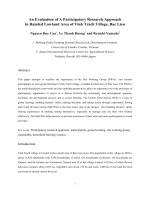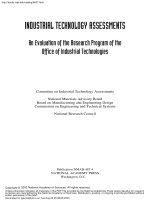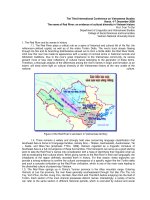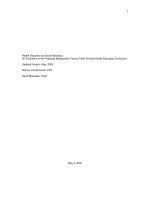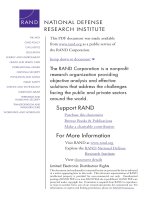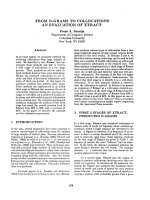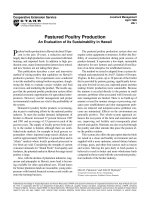Pastured Poultry Production An Evaluation of Its Sustainability in Hawaii pptx
Bạn đang xem bản rút gọn của tài liệu. Xem và tải ngay bản đầy đủ của tài liệu tại đây (155.28 KB, 7 trang )
Cooperative Extension Service
Livestock Management
April 1999
LM-1
Pastured Poultry Production
An Evaluation of Its Sustainability in Hawaii
P
oultry broiler production in Hawaii declined 30 per-
cent in the past 10 years, a reduction and trend
largely due to high production costs associated with land,
housing, and imported feeds. In addition to high pro-
duction costs, many former poultry farmers have retired,
and new farmers are not taking their place.
This publication describes a new and innovative
method of raising poultry that capitalizes on Hawaii’s
productive pastures. Two experiments were conducted
to test the method by raising broilers on pasture, slaugh-
tering the birds to evaluate carcass weights and feed
conversion, and marketing the product. The results sug-
gest that the pastured poultry production system offers
potential economic opportunities for agricultural entre-
preneurs. However, careful management and proper
environmental conditions are vital to the profitability of
the system.
Demand for poultry broiler products is increasing,
due in part to marketing efforts by the national poultry
industry. To meet the market demand, inshipments of
broilers to Hawaii increased 27 percent between 1987
and 1991 and an average of 3.5 percent in each of the
past ten years. The supply of locally grown fresh poul-
try in the market is limited, although there are estab-
lished niche markets, for example in local grocery su-
permarkets where imported range-raised chickens are
sold for approximately $8.00 for a 4-pound bird, and in
“ethnic” markets where locally produced processed or
live birds are sold. Considering the strength of current
consumer demands for “Island Fresh” food quality and
freshness, the potential market in Hawaii for range-raised
poultry is large.
Also, with the decline of plantation industries (sug-
arcane and pineapple) in Hawaii, more land is becom-
ing available for other agricultural uses. If land leases
for former plantation lands are reasonable, young entre-
preneurs with limited financial resources and credit can
enter the farming business.
The pastured poultry production system does not
require costly equipment or structures. It offers the flex-
ibility of seasonal production during peak seasons of
product demand. It represents a low-input, sustainable
alternative for new farmers and a potential diversifica-
tion of on-farm enterprise for established farmers.
The method we tested is adapted from a system de-
veloped and popularized by Joel F. Salatin of Swoope,
Virginia. In this system, up to 30 percent of the broiler
diet is provided by pasture grazing, significantly lower-
ing costs for feed (in our case, imported grain) and thus
making broiler production more sustainable. Because
the manure is recycled directly to the pasture in small
amounts, problems often associated with livestock ma-
nure management are limited. There is no build-up of
manure or need for manure storage or processing; nui-
sance pest establishment and odor management prob-
lems are reduced; and nonpoint-source pollution con-
cerns are minimized. Effects on the environment are
generally positive. This whole-system approach en-
hances the ecosystem of the farm and maximizes land
use, improving soil fertility and consequently plant
growth and quality. Nutrients are also recycled through
the poultry and other animals that graze the pasture af-
ter the poultry rotation.
This system also offers the perception that the birds
are raised in a clean and healthy environment and are
supplied with a more optimum, natural dietary balance
of forage, grain, and other feed sources such as insects
and worms. Moving the pens daily to fresh pasture is
believed to result in better and more wholesome birds
compared to those reared with the conventional produc-
tion methods of the broiler industry.
Glen K. Fukumoto
1
and John R. Replogle
2
1
Cooperative Extension Service, Kealakekua
2
Former owner-operator, Lelehune Farms, Kamuela
Published by the College of Tropical Agriculture and Human Resources (CTAHR) and issued in furtherance of Cooperative Extension work, Acts of May 8 and June
30, 1914, in cooperation with the U.S. Department of Agriculture. Charles W. Laughlin, Director and Dean, Cooperative Extension Service, CTAHR, University
of Hawaii at Manoa, Honolulu, Hawaii 96822. An Equal Opportunity / Affirmative Action Institution providing programs and services to the people of Hawaii without
regard to race, sex, age, religion, color, national origin, ancestry, disability, marital status, arrest and court record, sexual orientation, or veteran status.
LM-1 Pastured Poultry Production CTAHR — April 1999
The system advances the concept of “low-input,
sustainable agriculture.” No machinery is required for
manure handling. The structures are relatively low-cost
and portable. Poultry manure improves the pasture nu-
trient value for other classes of livestock with limited
negative environmental impact (odor, vector buildup).
Our studies raised four batches of birds to investi-
gate the feasibility and economics of producing a poul-
try on pastures in Hawaii and, to a limited extent on the
island of Hawaii, explore the market for fresh, locally
grown, pasture-produced poultry. We also investigated
the impact of the system’s mineral cycling on forage
quality changes and considered the potential soil fertil-
ity improvements.
Poultry production experiments
Growth experiment 1
We grew three groups of birds, each for 8 weeks. The
intention was for each group to have 100 Jumbo Cor-
nish-Rock cross birds, but the third group had only 73.
The chicks ordered were “straight-run” (non-sexed males
and females) vaccinated for Marek’s disease at the hatch-
ery. They were delivered by mail, arrived about 3 days
old, were raised in a brooder for about 4 weeks, and
then were placed in a portable pasture unit until pro-
cessed at 8 weeks of age. The pen was 12 x 10 ft in area
and 2 ft high, providing 1.2 ft
2
per bird at 100 birds per
pen. Half of the unit is enclosed for rain protection and
shade (Figure 1). The experiment was done in a mesic
grassland environment at 2800 ft elevation.
The pasture unit was moved daily, exposing the birds
to fresh forage. During the last week, the pasture unit
was moved twice daily. Figure 2 diagrams the 28-day
rotational grazing pattern used. Water and supplemen-
tal grain were available ad libitum throughout the pe-
riod. A commercial poultry finisher ration (21% crude
protein) was fed, although for one group a lower-pro-
tein formulation had to be used due to supply failure.
Records were taken on mortality, quantity of feed con-
sumed, feed cost, housing cost, and broiler production.
The three groups were grown in a 4-week sequence. At
8 weeks of age, the first batch was processed, the sec-
ond batch was moved from the brooder to the pasture
unit, and the third batch arrived and was placed in the
brooder.
Figure 1. Pasture poultry pens.
Above, the original design by Joel Salatin; below, a slightly
larger pen made of PVC pipe.
Growth experiment 2
We grew 101 straight-run Cornish-Rock cross broilers
that arrived 1 day old from a second distributor and were
processed 8 weeks later. The vaccination program,
brooder and growing phases, data collection, and loca-
tion were the same as in Experiment 1. The pen struc-
ture used PVC pipe rather than wood and was larger, 15
x 10 ft in area by 3 ft at the roof ridge, providing 1.5 ft
2
per bird (Figure 1). A commercial broiler starter ration
(22% crude protein) was fed.
The environment
In Experiment 1, soil and forage tissue samples were
taken before the grazing period, and more tissue samples
were taken after grazing. Soil testing included pH, sa-
linity, and extractable nutrients (calcium, magnesium,
phosphorus, potassium). Forage testing included dry
2
Return to starting point
LM-1 Pastured Poultry Production CTAHR — April 1999
Figure 2. Diagram of the 28-day grazing rotation.
The pen was moved daily during the first three weeks of the
grazing period and twice daily during the fourth week.
Start Week
Return pen to starting
point for next group
Week 1
Week 2
Week 3
Week 4
Week 4
1
2
3
4
matter and crude protein analyses. Rainfall and tempera-
ture data were collected throughout the study period. In
experiment 2, only rainfall data were recorded.
Processing
The broilers were custom-processed after withholding
feed and water for 12 hours. Some broilers selected at
random were weighed before processing. The processed
carcasses (with neck, abdominal fat, and no giblets) were
chilled in slush ice for about 1 hour, drained, and indi-
vidually weighed.
Product evaluation
The processed broilers were distributed to cooperators
for consumption. An informal survey evaluated opin-
ions on flavor, market acceptability, and overall impres-
sion of the product.
Economic analysis
We evaluated the costs and returns. A partial-budget
analysis assessed the marginal differences between two
marketing structures: one method based on a fixed price
per bird, and a second method based on price per pound.
Poultry growth on pasture
Data on growth for the two experiments are summa-
rized in Table 1.
Carcass weights for the three groups in Experiment
1 averaged 3.7 pounds and varied from 1.9 pounds to 5
pounds. This represented an overall dressing percent-
age of about 68 percent. The birds ate about 2.7 pounds
of feed for each pound of liveweight gain. The second
group had poorer performance because we had to change
feed type midway through the growth period, and the
new feed was lower in protein. Overall, about 17 per-
cent of the birds died, and about one-fourth of those
losses occurred in the brooder phase.
Experiment 2 produced larger birds with greater
carcass weights, averaging 5.5 pounds and varying from
3.5 to 7.2 pounds. The dressing percentage was about
75 percent. Each bird consumed 14 percent less feed
than those in Experiment 1, about 2.3 pounds per pound
Table 1. Growth performance of pastured poultry.
Experiment 1 (three groups) Experiment 2
1 2 3 All three
Number of birds at start 99 100 73 272 101
Number of birds processed 85 79 61 225 80
Ending age (days) 54 54 54 54 56
Mortality (%) 14 21 16 17 22
Total feed offered (pounds) 1250 1199 842 3291 1350
Average live weight per bird (pounds) 5.8 4.8 5.7 5.4 7.4
Average carcass weight per bird (pounds) 4.0 3.3 3.9 3.7 5.5
Feed conversion ratio* (pounds of feed per pound of gain)
Liveweight basis 2.54 3.18 2.43 2.71 2.30
Carcass-weight basis 3.72 4.66 3.56 3.97 3.08
*Liveweight basis feed conversion ratio was calculated from carcass weight based on a 68.3 percent dressing percentage estimated from a sample of birds.
3
LM-1 Pastured Poultry Production CTAHR — April 1999
of liveweight gain. About 22 percent of the birds died
because of cold, wet weather; just under half of these
losses were in the brooder.
Feed conversion ratios in these two experiments (2.3
and 2.7) are higher (or less efficient) than those expected
in conventional, confined rearing systems, where only
about 2.1 pounds of feed are normally required for each
pound of liveweight gain.
The grazing schedule was a 28-day rotation with a
total of 35 pen moves (Figure 2). The pen was moved
once a day during the first 3 weeks and twice a day dur-
ing the last week of the 4-week grazing period. The 10 x
12 ft pen thus used a total area of only 4200 ft
2
per graz-
ing period, whereas the 10 x 15 ft pen used 5250 ft
2
during the grazing period. The rotation period needed
before returning the pen to a previously grazed area de-
pends on the recovery and growth of the forage, which
will vary with the forage type, location, and environ-
mental conditions. During cool seasons or dry periods,
plant growth and recovery from grazing will be slow,
and rotation schedules must be devised that accommo-
date this variation.
The problem of feed supply we experienced with
one of the groups of birds underscored the critical need
for commitment from the feed dealer before starting a
project. These hybrid meat birds grow rapidly and need
a consistent feed supply. Changing from a finisher feed
with 21 percent protein to an all-purpose feed with 15
percent protein had a serious effect on bird growth.
Losses of birds
Bird mortality can have a major influence on financial
success and thus should be a major concern. In the con-
ventional broiler industry, the maximum mortality tol-
erated is 7 percent. We were concerned by the losses we
experienced, which we thought were high. We grouped
them into three main causes: weather, management, and
predators.
Weather. The weather was sometimes cool and it
rained daily. Experiment 1 was done from early spring
to mid-summer, under temperature ranging from 45° to
85°F and a total of 60 inches of rain. In Experiment 2,
the temperature ranged from 51° to 71°F, and late spring
rains brought 16 inches in two months, more than half
during the grazing phase. We believe that mortality was
high and growth was limited by the wet conditions
caused by rain, fog, and mist, compounded by cool tem-
peratures. We noticed crowding behavior in the pen cor-
ners, indicative of hypothermia. During such cold and
wet periods, installing a low-energy radiant heater within
the pen might reduce losses and improve production.
Management. We estimated that 2–3 percent of the
mortalities were due to management mistakes. More care
when handling the young chicks in the brooder and
moving the pasture pen would have reduced these losses.
Predators. We had planned to raise two groups in
the larger pen, but during the first attempt the entire flock
was killed in the brooder by mongooses. Although the
walls of the outdoor brooder were embedded in the
ground, the predator managed to burrow beneath them.
Subsequently, we installed a solid floor for the brooder
and we set two traps with spring-loaded doors along the
exterior walls. In the first two weeks of the next brood,
we trapped 16 mongooses. Placing such traps next to
brooders is highly recommended to reduce predator dam-
age. Some poultry producers believe that the chirping
of young chicks attracts mongooses, but once the birds
are 4–5 weeks old, the pest does not appear to be so
attracted.
We did not experience losses from carnivorous
predators during the grazing phase, but such losses are
possible and must be guarded against. A fairly level pas-
ture is needed to prevent mongooses, cats, or dogs from
burrowing into the pen. The pen cover should be se-
cured to exclude these animals as well as predatory birds.
Product evaluation
The responses to the meat produced were very positive
overall. Comments describing the product included
“moist,” “not filled with fat,” “no excessive fats remain-
ing after cooking,” “meat was firm yet tender and succu-
lent,” and “very good—moist and tender.” Samples from
Experiment 2 were distributed to local restaurant chefs,
who responded positively and expressed interest in pur-
chasing the product if there were a consistent supply.
Economic analysis
The economics of our experiments in pastured poultry
production are summarized in Table 2. The start-up cost
for the system is relatively low. The main operational
costs were incurred in feed (50–57 percent) and live-
stock purchases (17–21 percent), accounting for an av-
erage of 73 percent of the total cost of production. In a
comparison of two possible marketing methods, when
4
LM-1 Pastured Poultry Production CTAHR — April 1999
Table 2. Economic summary and marginal analyses of pasture poultry production and marketing.
Experiment 1 (three groups) Experiment 2
1 2 3 All three
Expenses
Birds 111.00 111.00 81.00 303.00 113.70
Feed 273.59 256.50 185.24 715.33 369.69
Feed supplements 5.00 5.00 5.00 15.00 30.00
Portable pasture pen
1
36.85 36.85 36.85 110.55 26.40
Supplies
1
16.55 16.55 16.55 49.65
Brooder bedding 18.09 18.09 18.09 54.27 25.10
Marketing 16.79 16.79 16.79 50.37
Processing supplies 42.93 42.93 42.93 128.79 80.00
Subtotal 520.80 503.71 402.45 1,426.96 644.89
Income
Method 1, number of birds 85 79 61 225 80
Priced per bird @ $8.00 680.00 632.00 488.00 1,800.00 640.00
Method 2, total weight (pounds) 336 257 236 829 438
Priced per pound @ $1.89 634.49 485.90 446.74 1,567.13 828.59
Net returns ($ return to labor)
Method 1
Per cycle 159.20 128.29 85.55 373.04 (4.89)
Per bird 1.87 1.62 1.40 1.66 (0.06)
Method 2
Per cycle 113.69 (17.81) 44.29 140.17 183.70
Per bird 1.34 (0.20) 0.72 0.62 1.66
Break-even price ($)
Method 1, per bird 6.13 6.38 6.60 6.34 8.06
Method 2, per pound 1.55 1.96 1.70 1.72 1.47
1
Amortized over 10 production cycles.
using a fixed price per pound, profit per bird marketed
ranged from a loss ($–0.20) to a gain of $1.66 (average
$1.05). With a fixed price per bird, the range was from a
loss ($–0.06) to a gain of $1.87 (average $1.22). Profits
reported by producers in the Midwest and East Coast
USA range from $1.00 to $3.00 per bird across both
marketing methods.
The per-bird pricing structure may be more profit-
able, but a strict quality control program that ensures
product consistency will likely be essential to gain con-
sumer confidence. The per-pound pricing method of-
fers the consumer a fair and understandable pricing for-
mat, but it forces the producer to optimize production
efficiency. We believe that Hawaii has both a suitable
niche market and a price tolerance for high-quality, lo-
cally produced broilers. In the Honolulu Chinatown
market, the price for locally produced broilers ranges
from $1.99 to $2.65 per pound for a 2
1
⁄2–3 pound car-
cass (including head, neck, and shank).
We suggest that a product label be developed for
use in the evaluation and distribution of range-fed broiler
products. The label could list harvest schedules to allow
consumers to place advance orders.
The environment
No adverse environmental effects were observed with
the poultry pasture production system. There were no
odor problems from manure deposition. With the per-
sistent rains during the study period, surface manure
moved through the top layer of sod within a week. No
fly breeding was observed. Regrowth of the pasture grass
after poultry grazing was excellent. Within two weeks
5
LM-1 Pastured Poultry Production CTAHR — April 1999
of grazing, obvious dark green regrowth patterns trailed
the path of the pasture pen. However, palatability of this
dark green growth appeared to be negatively affected at
first, possibly due to odor. We observed that a minimum
of 30 days of rest was required before other grazers
(sheep and cattle) took to the lush forage.
Samples of the 4-week old regrowth showed a 37
percent increase in crude protein value of the pasture
grass, a combination of kikuyugrass (Pennisetum
clandestinum) and pangolagrass (Digitaria decumbens).
Unfertilized by the grazing system, the forage’s crude
protein value was 14
1
⁄2 percent, compared to nearly 20
percent a month after being grazed by the poultry. Be-
yond the 30-day resting period, we observed that graz-
ing animals selected the naturally fertilized forage pref-
erentially.
Soil changes are not expected to be immediate, but
over time, improvement in the soil’s plant nutrient sta-
tus is expected. In the test area, soil analysis results
showed low levels of phosphorus (14 ppm), medium
levels of potassium (180 ppm), medium levels of cal-
cium (1600 ppm), and medium-low levels of magne-
sium (280 ppm). Soil pH was 5.5. Fertilizer recommen-
dations for pasture in this area specify 1500 pounds of
16-16-16 fertilizer per acre per year.
To illustrate the potential nutrient cycling of this sys-
tem, we propose the following 1000-bird scenario. Con-
tinuous operation (10 cycles per year) of 10 pens will
produce approximately 11 tons of wet manure spread
over 1 acre. Placing a conservative fertilizer value for
the manure of 2-3-3 (percent N-P
2
O
5
-K
2
O), its applica-
tion through the poultry pasture system will have a posi-
tive impact on the pasture’s mineral cycle equivalent to
112, 174, and 174 pounds per acre per year of N, P
2
O
5
,
and K
2
O, respectively. The nutrient recycling will result
in enhanced forage production and quality and improved
animal performance.
Conclusions and recommendations
We suggest that improvements and efficiencies can be
gained in the pastured poultry system in two areas. First,
reduction of death losses. To improve chances for suc-
cess, increased management should reduce mortality to
below 7 percent. Birds should be prevented from clus-
tering in the pen corners, which may cause suffocation.
Care when moving among the birds and shifting the pen
will prevent crushing. Providing more shelter in adverse
weather conditions or incorporating a low-energy radi-
ant heat source for the birds will improve survival.
Second, options that will lower feed costs need to
be investigated. Try to secure commitments from your
local feed dealer for a consistent supply of the feed se-
lected. Purchasing in bulk can reduce feed costs. Feed
price for our experiments was approximately $0.22 per
pound, about $440.00 per ton.
Third, our results suggest that drier environments
may be better than cold, wet locations.
Another strategy that can be incorporated into the
system is to stagger processing times. This can improve
the efficiency of production in two ways: first, by re-
ducing mortality risks over a shorter period, and sec-
ond, by improving feed conversion. Instead of process-
ing an entire group at 8 weeks, process half of the group
at 5 weeks and the second half at 7 weeks of age, select-
ing the larger birds for the first processing. This strat-
egy of “topping off” will likely lead to a reduction in
total mortality by lowering the group population during
the pasture phase. The second benefit relates to the bird’s
physiology—as the broiler matures, feed efficiency de-
creases.
Feed-to-gain ratios for broilers have been mea-
sured with birds that were 2, 4, and 6 weeks old (Patterson
et al. 1994).
The amount of feed required per pound of
gain increased for each age group (1.29, 1.68, and 2.41
pounds, respectively). The feed conversion ratio calcu-
lated over the entire period was 1.89, which resulted in
a 4.07-pound (live weight) broiler. By processing the
broilers at a younger age, the feed conversion ratio will
be lower, thus increasing efficiency of the system.
Our project was on a tropical grass pasture, but other
forage options can be used. Legume forages mixed with
the grasses would provide higher crude protein content
and increase the diversity of the feed supply. In addi-
tion to adding this system to pastures grazed by live-
stock, it can be used on cover crops in orchards or on
crop residues within a vegetable farm rotation.
Expansion of the pasture-raised poultry market in
Hawaii is limited by the availability of federally in-
spected slaughter facilities. The key element for any live-
stock meat production enterprise is the slaughter and
processing facility. Without this allied industry partner,
wholesale distribution of inspected meat products is not
permitted under the United State Department of Agri-
culture, Food Safety and Inspection Service, Meat and
Poultry Inspection program.
6
LM-1 Pastured Poultry Production CTAHR — April 1999
Pastured poultry production is a potential business
enterprise for the small-farm entrepreneur. The demand
for “Island Fresh,” locally produced broilers is strong,
and the potential for developing pasture-raised poultry
as a premium niche-market product is high. Compared
to conventional poultry broiler production methods, this
broiler production system uses more “natural” methods,
which may be of value to some consumers, and involves
a convenient and environmentally sound waste manage-
ment strategy.
References for further information
Patterson, P. H., N. Acar, and W.C. Coleman. 1994. Feed-
ing value of poultry by-products extended with cas-
sava, barley, and wheat middling for broiler chicks:
The effects of ensiling poultry by-products a preser-
vation method prior to extrusion. Poultry Science
73:1107-1115.
Rynk, Robert (editor). 1992. On-farm composting hand-
book. Northeast Regional Agricultural Engineering
Service, Cooperative Extension Service, Ithaca, NY.
NRAES-54.
Salatin, Joel F. 1996. Pastured poultry: poultry inspec-
tion exemptions. The Stockman Grass Farmer, vol.
53, no. 2, p. 14. Mississippi Valley Publishing Corp.,
282 Commerce Park Dr., Ridgeland, MS 39157.
Salatin, Joel F. 1991. Pastured poultry manual: the
Polyface model. Polyface, Inc., Swoope, VA. 24479.
Acknowledgments
This project was selected and funded by the program on
Low Input Sustainable Agriculture for Hawaii’s Diver-
sified Crops and the Sustainable Agriculture Resource
Committee. Additional funds were provided by the plan-
ning committee of the Mealani Forage Field Day and
Taste of the Hawaiian Range Food Show. Joel Salatin
generously shared his expertise on pastured poultry pro-
duction in Virginia with the authors. Others who helped
with the project include Rick Habein, who provided
pasture; Earl Spence, who constructed the pasture pens;
John Swift, who allowed use of slaughter equipment;
Scott Green, Velvet, Conor, and Asher Replogle, who
assisted the work; and Milton Yamasaki, farm manager,
and the agricultural technicians of the CTAHR Mealani
Research Station. Review of the manuscript was pro-
vided by Paul Patterson, Department of Poultry Sciences,
at Pennsylvania State University, and Kathleen Delate,
Department of Horticulture and Agronomy, Iowa State
University.
7

